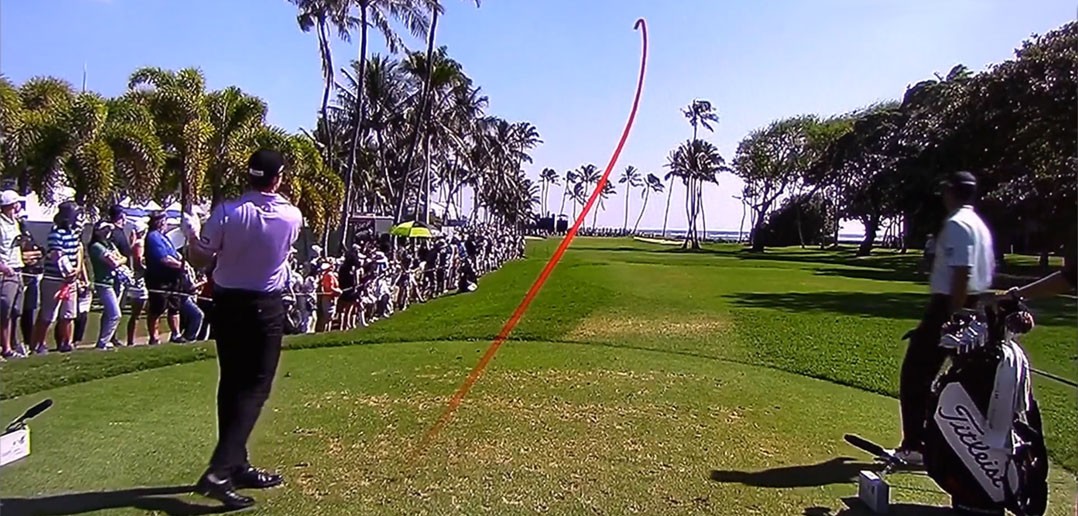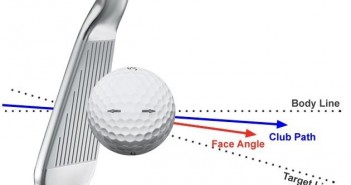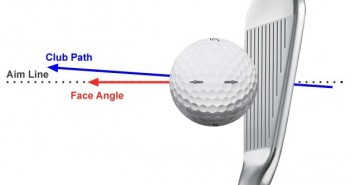Yes, generally, drawing the golf ball will make it travel a longer total distance than hitting a fade.
In the article, we’ll explain why.
Apologies to the lefties out there, but, for simplicity, this article will describe shots from a right-handed golfer’s perspective.
We were recently challenged by a new student, when we were teaching the laws of ball flight.
This student had seen some instruction on the internet that claimed that a draw and a fade were the same, in terms of distance.
The argument, basically, was that the ball doesn’t know whether it’s spinning to the right or to the left.
Therefore a draw is just a mirror of a fade, all else being equal.
Well, it’s true to say that the direction of the spin, left versus right, draw spin versus fade spin, won’t in itself change the distance that the ball travels.
But to infer from this that a draw and a fade are equal is a big mistake.
It’s a specious argument; “all else” is never equal, and this sort of misleading instruction makes us furious because it hinders students’ progress.
A draw and a fade are about far more than spin direction, and the impact conditions required to create either will produce very different results.
Sidespin Doesn’t Exist
Let’s start by clearing up a common misunderstanding.
There is no such thing as sidespin on a golf ball.
With anything remotely like a normal golf stroke, it is impossible to put sidespin on the ball.
Basic physics (the principles of angular momentum) tells us that, if a ball is reasonably balanced, it will spin in only one direction at any point in time.
That direction may change over time, as other forces such as drag are applied during the ball’s flight and its later interaction with the ground, but you can’t possibly have backspin and sidespin – and striking the ball with a golf club creates so much backspin that sidespin is impossible.
The ball curves through the air, not because of sidespin, but because the spin axis is tilted.
Tilting the spin axis left will cause the ball to curve left through the air, because the lift produced by the spin will be directed more to the left – like banking an aircraft.
Impact Conditions
For a normal shot from the tee or fairway, backspin is imparted on the golf ball primarily by club head speed and the loft of the club.
The amount of spin produced (the spin rate), for a given club head speed, depends on something called spin loft – higher spin loft produces more spin.
Spin loft is the angle between the effective loft of the club face at impact (dynamic loft) and the attack angle of the club head.
The dynamic loft is the natural loft of the golf club (e.g. 31° for a 6 iron) adjusted by the face angle and the forward lean of the club shaft at impact (about 11° down for a Tour pro).
So, a steeper angle of attack will increase the spin loft and produce more spin.
More forward shaft lean will reduce the spin loft and produce less spin.
Tilt in the spin axis is produced when there is an angle between the club face and the club path in the horizontal plane – the greater this angle, the more the spin axis is tilted.
If the club head is moving to the right of the face angle through impact (coming from the inside), this will tilt the spin axis of the ball to the left, and the ball will curve left through the air – it will draw.
Note that producing spin requires energy. More spin means less energy transferred to the ball in the form of ball speed, a lower smash factor, and the ball won’t go as far.
In effect, producing axis tilt requires a “glancing blow” that will reduce the efficiency of impact.
Note also that, contrary to popular belief, the initial ball flight direction is influenced mostly (about 85%) by the face angle, and only slightly by the club head path.
If you strike the ball with the club face square to the target line and with an inside club head path, it will start straight and then draw.
To hit a “traditional” draw, where the ball starts slightly right and then draws back to the target, you need to have the club face slightly open at impact (to start it right), and the club path even more from the inside (to spin it left).
Having the club face closed at impact with the club coming from inside the target line will produce a very nasty pull-hook.
The angles involved are very small, less than a second on a clock face, unless you’re Bubba Watson!
The Draw
To produce draw spin, the club head must approach impact from inside the face angle – the face must be closed relative to the club path.
For example, a club head path of 4° from the inside, relative to the target line, with the club face 2° open at impact, will produce a draw – starting the ball right and curving it back towards the target. The open face starts the ball right, the relatively inside path curves the ball left.
Closing the face will reduce the dynamic loft (in some respects turning your 6 iron into a 5 iron).
Attacking the ball from the inside will also produce a shallower angle of attack.
So, less loft and shallower attack angle produces a lower spin loft.
Lower spin loft means less spin and a more efficient transfer of speed-producing energy to the ball.
Lower loft and more ball speed produces more distance.
And less spin means the ball will roll more after it lands.
The Fade
To produce fade spin, the club head must approach impact from outside the face angle – the face must be open relative to the club path.
For example, a club head path of 4° from the outside, relative to the target line, with the club face 2° closed at impact, will produce a fade – starting the ball left and curving it back towards the target. The closed face starts the ball left, the relatively outside path curves the ball right.
Note: Many amateurs think that they slice the ball because their club face is open at impact. If the ball starts right and then curves further right, this may be the case. But if the ball starts straight or left and then curves right, this is because your club path is too far from the outside, usually caused by swinging “over the top”. A stronger grip or closing your stance are not the proper solutions, they are the road to ruin!
Opening the face will increase the dynamic loft (in some respects turning your 6 iron into a 7 iron).
Attacking the ball from the outside will also produce a steeper angle of attack.
More loft and steeper attack angle produces more spin loft.
Higher spin loft means more spin and a less efficient transfer of speed-producing energy to the ball.
Higher loft and less ball speed produces less distance.
And more spin means the ball will stop more quickly after it lands.
The result: a draw will generally travel further than a fade.
There are other factors at work, such as the wind, the lie of the land, the softness of the fairways, etc. But as a general rule, a draw is longer.
Does this Mean that a Draw is Better?
No, not necessarily.
Although a draw will generally travel further than a fade, which might be seen as a good thing, there’s more to it than that.
A fade will have more spin, producing more lift, which will often mean that it stays in the air for longer and carries further. The ability to, say, carry a fairway bunker, might mean that you are able to get the ball further down the fairway with a fade.
And the ability to carry the ball onto the green and stop it quickly is often essential if you want to leave yourself a short putt, and a fade will often do this best.
Also, the draw will generally roll further. A rolling golf ball is at the mercy of the contours of the fairway, and may be likely to roll deep into thick rough.
Generally speaking, a fade gives you more control and is often favoured by elite players.
Straight is Best
Overall, however, the most effective shot shape is usually the straight one.
If you don’t want to shape the ball for some special reason – perhaps holding it into the wind or rolling the ball to a back-left pin position – then hitting it straight is the most efficient way to strike a golf ball.
Hitting the ball straight means having minimal difference between the face angle and club head path through impact, which will maximise the transfer of speed-producing energy to the golf ball (smash factor).
You may have heard that a draw or fade is easier than hitting it straight, but that’s not really true.
The straight shot maybe more difficult than “any old draw”, but it’s certainly no more difficult than, say, a shot that starts out 2 degrees right and then draws back 6 yards to the target.
For specific accuracy and control, a straight shot is at least as easy as a draw or a fade.
There are certainly many reasons why you may favour a particular shot shape for any given shot, not just the wind direction or pin placement.
If you’re tense, maybe you’re 1-up with 2 to play against your biggest rival, then you may have a go-to shot shape that you know you can rely on.
Or maybe there’s water right of the green and missing left is benign – if you’re protecting a good lead then you may decide to start the ball at the centre of the green and err on the side of a draw.
Or maybe you want to attack that back-right pin position “just because you can”.
The best of all worlds: first learn how to hit the ball straight, then learn how to shape the ball when you wish to – high and low as well as draw and fade.
With the Swing like a Champion system, you will quickly learn how to play all 9 shots at will.
If you have any questions or comments about this or other articles on Golf Loopy, please send us an email.
» The Mechanics of Golf Ball Flight.




